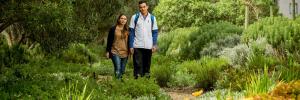
Sustainability in practice at SU
Sustainability is the buzzword of the 21st century and a major focus of Stellenbosch University. Recent developments which aim to further environmental sustainability on our campuses show exactly how.
According to the World Commission of Environment and Development, sustainability is the ability to provide for current human needs and to enhance and develop quality of life without increasing the consumption of materials and energy more than the current support systems can tolerate. So what exactly does sustainability mean for Stellenbosch University?
"Sustainability is an indispensable element of the university's Institutional Intent and Strategy, says Dr Barbara Pool, Director: Projects, who manages the Sustainability Initiative. "The university must be sensitive to the ecological footprint of our activities, for example in our research, as well as facilities, such as buildings, experimental farms and gardens, on the environment," she adds.
Sustainability also refers to the impact of activities on people, society and the economy. "This is particularly relevant for us as a university as our core functions of learning and teaching, research and social impact are all directed towards people," says Pool.
In response to these sustainability goals, the university runs numerous water-related, recycling, energy-saving and mobility initiatives. "In addition, we have a number of other exciting projects that are already bearing fruit, such as the conservation of mountain areas, regular tree planting initiatives, an 'eco walk' at our Tygerberg campus and the owl box project at the Stellenbosch campus," says Pool.
The Tygerberg campus is situated in what would have historically been home to Cape Flats Sand Fynbos (CFSF). However, rapid urbanisation has caused most of this type of vegetation to be eradicated, with only 15% left and only 5% in good condition. When the student residence Ubuntu House was constructed on the Tygerberg campus, an opportunity arose to establish new landscaping around the building. After consultation with botanists from the City of Cape Town and Plattekloof Heritage Site, a range of CFSF plants were identified for use in a new eco walk.
"The idea behind the eco walk is for campus users to be able to stroll or jog around the campus along a trail surrounded by local fynbos. So far, about 250m of the eco walk has been installed, and an estimated 1km will be available once stage 3 of the project is completed. The ultimate goal is for the eco walk to extend around the entire perimeter of the campus," says Meg Hamilton, Environmental Manager at SU's Facilities Management.
The same indigenous plant palette has been extended to all new landscapes on the Tygerberg campus and any new plants used are restricted to the list of species decided on in consultation with botanists from the City of Cape Town and Plattekloof Heritage Site. In total, an estimated 5 030m2 of landscape on campus is now indigenous to the area, firmly establishing Tygerberg's identity as a "green" campus. Some of the plants that may be found in these fynbos areas on campus include proteas, restios, asters and ericas. Indigenous annuals and bulbs are also predominant during spring. Besides the natural beauty of the fynbos, it also offers a number of advantages.
The CFSF is naturally adapted to the local climate and therefore requires less irrigation in the summer months and can also manage the very wet winter conditions. "The fynbos also adds to the biodiversity of the area by establishing a green corridor in a predominantly urban area, thereby attracting birds and other fauna occurring naturally in the area. This results in less need for the use of pesticides, as the local fauna act as natural predators," she says.
Ideally, an ecologically sustainable campus is one where no chemical poisons are used to control pests. One solution to this dilemma is to increase the number of predatory birds on campus, thereby reducing the need for bait stations that are used to control rats, mice and other rodents. For this reason, the owl box project was launched at the Stellenbosch campus.
"Both spotted eagle owls and barn owls live and breed in the urban green belts that wind their way through the suburbs in most areas of the Western Cape. To encourage these owls to visit the Stellenbosch campus, 10 owl boxes were installed in 2012 and 2013 across the campus. The rationale was to provide breeding sites within the campus gardens for these birds," says Hamilton.
It is hoped that pairs of owls will eventually use these artificial spaces to raise their young, thereby contributing to the control of rodents and numerous insect species. "Young owls reared in these boxes often return to the same area to raise young of their own. This characteristic, known as natal recognition, results in birds moving into the area where owl boxes are supplied," adds Hamilton.
While a few spotted eagle owls have been seen on campus, barn owls have yet to make their appearance.
"The university's Sustainability Initiative has already delivered a host of benefits to the environment, people and our financial viability. Much work lies ahead, but, with the cooperation and enthusiasm we have experienced thus far, the university can look forward to a very long and sustainable future," concludes Pool.
CAPTION: The Eco Walk at the Tygerberg campus. Photo: Stefan Els
- This article is published in the latest edition of the SU magazine, Matieland. Read the magazine at www.sun.ac.za/matieland. You can also register on this website to receive the magazine for free.
